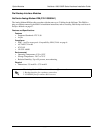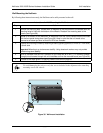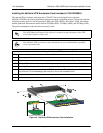
Unit Installation NetVanta 1000/1000R Series Hardware Installation Guide
56 Copyright © 2008 ADTRAN, Inc. 61200500L1-34N
Supplying Power to the Unit
NetVanta 1000 and 1000R Series AC-Powered Units
The AC-powered NetVanta 1000 and 1000R Series units come equipped with an auto-sensing 100 to 250 VAC,
50/60 Hz power supply for connecting to a properly grounded power receptacle. (A detachable power cable with
a grounded, three-prong plug comes with the shipment.) To power these units, connect the power cable to an
appropriate AC power source.
NetVanta 1224STR (DC)
The DC-powered NetVanta 1224STR connects to a centralized DC power source via the four-position power
connector on the rear of the chassis (see Figure 37 on page 57). Power and ground connections require copper
conductors and a ring lug.
Instructions for Connecting DC Power Source to the NetVanta 1224STR
Step Action
1 With the power disconnected, connect the primary power source to input A of the power
connector.
2 Connect a ground wire (fitted with a loop terminal end) to the grounding point using the screw
provided. Connect the other end of the ground wire to a protective earth ground. See Figure 37
on page 57.
3 If using a backup power source, connect it to input B of the power connector.
• Power to the NetVanta 1224STR DC System must be from a reliably grounded 24 or
48 VDC.
• Use only copper conductors when making power connections.
• Install unit in accordance with the requirements of NEC NFPA 70.
• The branch circuit overcurrent protection shall be a fuse or circuit breaker rated
minimum 48 VDC, maximum 10 A.
• A readily accessible disconnect device, that is suitably approved and rated, shall be
incorporated in the field wiring.
• Maximum recommended ambient operating temperature is 50
°C.
The 10/100BaseT and Gigabit Ethernet interfaces MUST NOT be metallically connected
to interfaces that connect to the Outside Plant or its wiring. These interfaces are designed
for use as intra-building interfaces only. The addition of primary protectors is not
sufficient protection in order to connect this interface metallically to OSP wiring.


















